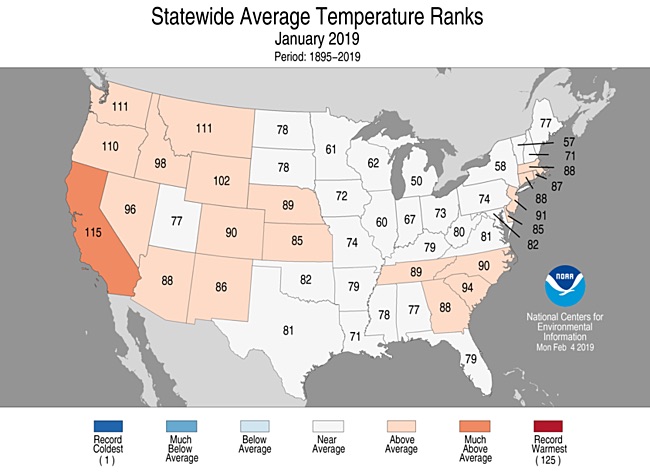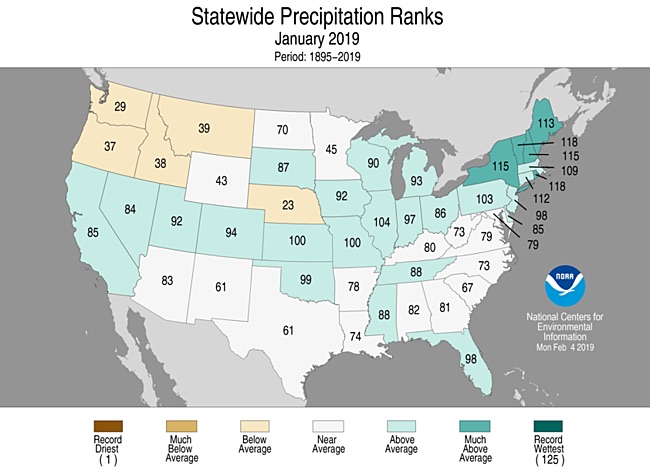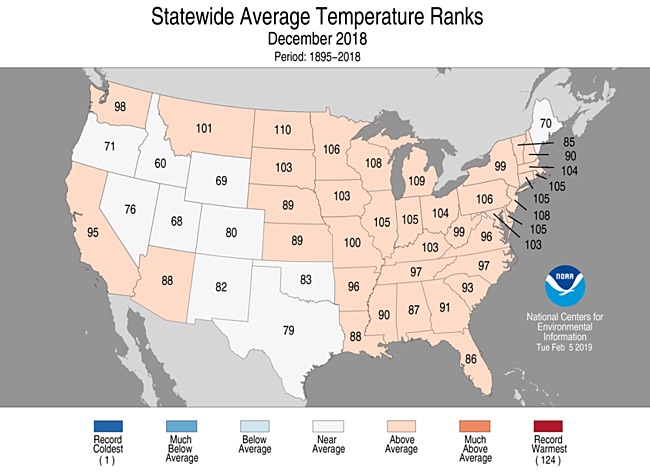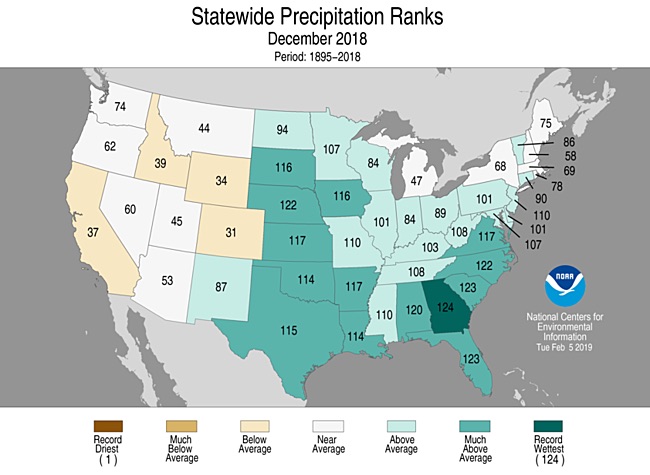| Above: A view of the Chicago lakeshore as temperatures hovered around –20°F on January 30, 2019. Businesses and schools closed, Amtrak suspended service into the city, more than a thousand flights were cancelled, and mail delivery was suspended as the city coped with the extreme low temperatures. Image credit: Bilgin Sasmaz/NurPhoto via Getty Images. |
Despite the sharp turn toward Arctic cold in the U.S. Midwest and Northeast during the last few days of January, the rest of the month was so mild that none of the contiguous U.S. states ended up significantly below average for January as a whole, according to the January U.S. climate report from NOAA’s National Centers for Environmental Information. The month ended up as the 29th warmest in 125 years of recordkeeping.
A few states, especially in the Midwest, were slightly cooler than average—but even these areas were largely milder than normal until the last several days of January. Meanwhile, parts of the South and most areas from the Rockies westward were notably milder than usual for the month. No states ended up with a top-ten warmest or coldest January.
Another sign of warmth's counterintuitive presence in 2019 so far: Up through February 8, the year has produced 1713 daily record highs but only 520 daily record lows, according to NCEI's Daily Weather Records site. Likewise, there have been 21 all-time monthly highs but just 7 all-time monthly lows. Update (12 February): The Daily Weather Records site is currently showing no data for the period from Jan. 28-31, when many cold records were undoubtedly set, so the ratio of warm-to-cold records for the year to date is almost certainly lower than shown here, and it could in fact be less than 1:1. Thanks to Guy Walton for bringing this to our attention.
 |
| Figure 1. Statewide rankings for average temperature for January 2019, as compared to each January since records began in 1895. Darker shades of red indicate higher rankings for heat, with 1 denoting the coldest January on record and 125 the warmest. Image credit: NOAA/NCEI. |
When it comes to temperature extremes, by far the most impressive day of the month was January 31, when the extreme intrusion of Arctic air crested in the Midwest. At least four cities set or tied all-time record lows:
- –33°F in Moline, Illinois, shattered the all-time record low of –28°F from Feb. 3, 1996 on Thursday, in records dating to 1874. (The all-time low from 1996 was actually broken just before midnight on Wednesday night, with temperatures dropping further early Thursday.)
- –31°F in Rockford, Illinois, on Thursday beat the previous record of –27°F from Jan. 10, 1982, in records dating to 1893.
- –30°F in Cedar Rapids, Iowa, on Thursday beat the previous all-time record at the city's official reporting site (the Cedar Rapids airport) of –29°F from Jan. 15, 2009, in records dating to 1953. (The all-time record for the entire Cedar Rapids area remains –33°F, set on Jan. 16, 2009, at the Cedar Rapids No. 1 reporting site, where records began in 1892.)
- –43°F northwest of Mather, Wisconsin, on Wednesday tied the all-time low from Jan. 30, 1951, in records dating to 1903.
At Mount Carroll, Illinois, the low of –38°F on January 31 was colder than the current Illinois all-time record low of -36°F set on Jan. 5, 1999, in Congerville, IL. NCEI’s State Climate Extremes Committee will be reviewing this potential new record in the coming weeks.
According to weather records expert Maximiliano Herrera, who tracks all-time heat and cold records for thousands of major stations globally with a 40-year plus period of record, the all-time cold records set on January 31 in the U.S. Midwest were the first such records globally in the northern winter of 2018–19. We’ve never gone so deep into January without an all-time cold record being set since global record-keeping began, says Herrera. In contrast, in the Southern Hemisphere, where it is summer, January 2019 saw two nations or territories and 47 stations set their all-time heat records.
 |
| Figure 2. Statewide rankings for average precipitation for January 2019, as compared to each January since records began in 1895. Darker shades of green indicate higher rankings for moisture, with 1 denoting the driest January on record and 125 the wettest. Image credit: NOAA/NCEI. |
The contiguous U.S. had its 37th-wettest January on record, according to NCEI. Vermont and Rhode Island each saw their 8th-wettest January, while no states had a top-ten-driest January. Multiple snowfalls socked large parts of the Midwest and Northeast. In the Midwest, the relative wetness continued the trend from 2018—which was the region’s single wettest year in records going back to 1895, according to the Midwest Regional Climate Center (as noted in NCEI'S January report).
In Caribou, Maine, 59.8” of snow fell, smashing the old January record of 44.5” from Jan. 1994. The snowfall came just short of Caribou’s all-time monthly record of 59.9” (Dec. 1972).
There it is, I see the sun! #mewx pic.twitter.com/Tmq6BSs6dj
— NWS Caribou (@NWSCaribou) February 1, 2019
 |
| Figure 3. Statewide rankings for average temperature for December 2018, as compared to each December since records began in 1895. Darker shades of red indicate higher rankings for heat, with 1 denoting the coldest December on record and 124 the warmest. Image credit: NOAA/NCEI. |
December was even milder and wetter than January
NCEI is in catch-up mode after the prolonged government shutdown, so the agency’s full report on U.S. climate in December 2018 has not yet been issued. Graphics and time series for the month are now online, though, and they show that the contiguous U.S. had its 7th-wettest and 21st-warmest December in 124 years of recordkeeping.
December’s warmth was shared broadly across the nation, with every state running near or above average. No state had a top-ten warmest December, though. Georgia saw its wettest December on record, and 11 other states across the Great Plains and Southeast notched their top-ten-wettest Decembers.
Dr. Jeff Masters contributed to this post.
 |
| Figure 4. Statewide rankings for average precipitation for December 2018, as compared to each December since records began in 1895. Darker shades of green indicate higher rankings for moisture, with 1 denoting the driest December on record and 124 the wettest. Image credit: NOAA/NCEI. |



